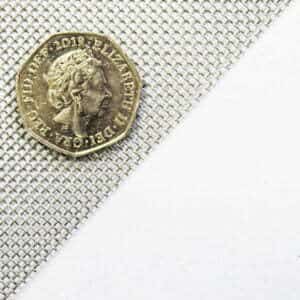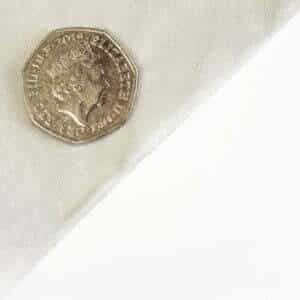







£11.99 – £249.99 inc VAT


This website is secured:
✔ The UK’s Largest Range Of Mesh Products
✔ FREE UK Delivery Included
✔ Immediate Express Dispatch From Stock
✔ Tracked Delivery with Order Updates
✔ 30-Day Returns Accepted
£ Check Out Our Clearance Listing For Savings
@ ☏ Bespoke Sizes & Larger Sheets Available
This 304 stainless steel woven wire mesh is the epitome of durability and versatility. With 256 holes per square inch and a wire thickness of 0.4mm, this mesh offers excellent airflow and a robust barrier. Resistant to corrosion and easily tailored with standard scissors or tin snips, it’s an ideal choice for diverse applications, guaranteeing longevity and top-notch performance.
1.19mm hole coarse woven stainless steel mesh in top quality 304 grade made from 0.4mm wire. As you can see from the image, this is a coarse mesh specification. This mesh is fairly coarse, but the holes are very small and not especially visible by naked eye. It is of interest to anyone who needs a coarse for any application. You would be able to bend this mesh by hand very easily. Once bent it would hold its shape.
This 304 stainless steel woven wire mesh combines durability with versatility. This finely crafted mesh, designed with 16 holes per linear inch, results in an impressive 256 holes per square inch, offering a unique balance between permeability and security. Each wire exhibits a thickness of 0.4mm, ensuring the mesh remains robust and resilient against wear and tear. With an aperture size of 1.19mm and an open area percentage of 55.96%, it offers ample airflow while maintaining its protective barrier capabilities. Notably, the mesh is constructed from 304 stainless steel, a grade known for its corrosion-resistant properties, ensuring longevity even in challenging environments. Its adaptability goes further: it can be seamlessly tailored to specific requirements, easily cut using standard kitchen scissors or tin snips. Our recommendation is scissors for precise adjustments. Choose our stainless steel woven wire mesh for a product that epitomises strength, durability, and ease of use. Ideal for a myriad of applications, this mesh is a testament to superior craftsmanship and quality.
The specifications of this woven wire mesh are as below:
Wait!! Before you order your mesh please first check out our clearance listing which is where we put all of our over-run bargain rolls at reduced prices. You never know, you might find just the roll that you need for your purposes.
We also offer a massive range of 304 stainless steel perforated metal sheet options from immediate stock. In order to produce stainless steel perforated metal sheet, flat sheet metal is punched with round or square holes. Perforated sheets are commonly often used in applications where the passing of air is required. Because the holes are punched, it is possible to have a far stronger finished metal product than it would be for the equivalent thickness in woven or welded mesh.
Our group have been in the mesh industry for over 150 years. We are one of the UK’s most trusted mesh suppliers because:
The Mesh Company has an enormous range of woven gauze metal products. We truly are an industry leader among suppliers of weld mesh and woven wire materials. With the capabilities we have in-house, we can provide virtually anything you require.
Copper, brass, black, and galvanised steel wire mesh materials are also available in large stock quantities at bargain prices. See our blog for specific information on all of our various
The 304 grade, often referred to as A2 stainless steel, is one of the most widely used stainless steel grades, primarily because of its excellent corrosion resistance. The corrosion-resistant properties of 304 stainless steel can be attributed to its specific chemical composition and the formation of a protective surface layer. Here’s how it works:
The open area percentage of a mesh is a measure of how much of the mesh is open space as opposed to the material (in this case, wire). It provides an indication of the mesh’s transparency, airflow capability, and filtration potential. To calculate the open area percentage for a mesh:
Mathematically, it can be represented as: Open Area %=(Open AreaTotal Area)×100Open Area %=(Total AreaOpen Area)×100
There are a number of applications for The Mesh Company’s 304 stainless steel woven wire mesh. Because of its robustness and corrosion resistance, it is an ideal choice for security measures, such as window screens or protective barriers in various industrial environments. The filter’s aperture size of 1.19mm makes it an ideal candidate for filtration tasks, as it efficiently sifts larger particles while allowing smaller elements and liquids to pass through. This functionality has found its place in both industrial processes and domestic settings, such as in finely crafted sieves or strainers.
In addition, due to its resilience and design attributes, it is perfect for animal enclosures, ensuring a safe environment for pets while also ensuring ample ventilation. In addition to these uses, it has also found use in agriculture, especially in safeguarding plants and facilitating controlled growth. As a result, this mesh provides aesthetics, durability, and function for a broad range of applications.
Check out our blog ‘everything that you need to know about woven filter mesh’ for more information on this product. Our goal for our blogs and help guides is to answer as many questions as possible to help to explain the possibilities of mesh to our customers. Contact our team today if you have any questions at all. We are always really keen to help in any way that we can.
You may also be interested in our blog about hardware cloth. This article explains the term in great detail.
We also offer similar products through our highly popular eBay store, check us out there too.
| Woven Mesh Sheet Size | 150 x 150mm x 2 Pack, A4 x 4 Pack (210 x 300mm x 4 Pack), 300 x 300mm (30 x 30cm) Sheet, A3 x 3 Pack (300 x 420mm x 3 Pack), 500 x 500mm (50 x 50cm) Sheet, A2 420 x 594mm (42 x 59.4cm) Sheet, A1 594 x 841mm (59.4 x 84.1cm) Sheet, 1000 x 500mm (100 x 50cm) Sheet, 1000 x 1000mm (100 x 100cm) Sheet, 5 Metre x 1000mm (1 Metre) Roll, 10 Metre x 1000mm (1 Metre) Roll |
|---|
In 2008 Locker Wire Weavers launched The Mesh Company to bring our enormous range of wire mesh products to the general public for the first time. Previously wire mesh was only available for trade customers.
We continue to extend our range, and now proudly offer many forms of mesh and metal products for the best possible prices. We specialise in woven wire mesh. As a group we work closely with architects and designers to develop ground-breaking new applications for our multifunctional range of materials. We also offer state of the art fabrication and engineering for projects of all sizes.
Strong ties with the Warrington community continue to be at the very core of our business. We are proud to invest in the training and developing our staff of all levels in line with the traditions set by Thomas Locker, who founded our group 150 years ago when he invented the electronic loom. We continue to bring ingenuity and strong ethics to our day to day business.
The Mesh Company continues Warrington’s historic role in the wire industry. For more than 140 years, our group has been a leader in the supply and manufacture of woven wire mesh and wire cloth. Having been founded in Warrington, UK in 1878, Locker mesh products still retain the quality craftsmanship and spirit of innovation that were so characteristic then.
Available Options
You will find full rolls of this insect netting here. Please be advised that the majority of woven mesh is usually available in a maximum roll size of 30 metres by 1200mm. Please email us if you wish to discuss purchasing this mesh in any size – sales@themeshcompany.com.
Feel free to call us if you wish to discuss any of our products – (+ 44) 01925 406 602. We are always happy to help in any way that we are able to.
We also offer this product through our highly popular eBay store, check us out there too.




The largest range of wire mesh, chicken wire, wire fencing, woven wire mesh and perforated metal products in Europe, delivered direct from our Warrington warehouse.




Website by: Beech Web Services | Terms and Conditions | Cookie Policy | Privacy Policy | Website Terms and Conditions
Reviews
There are no reviews yet.